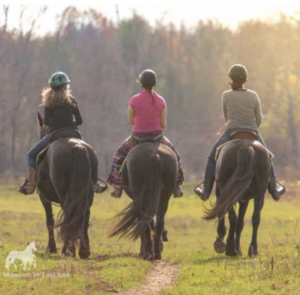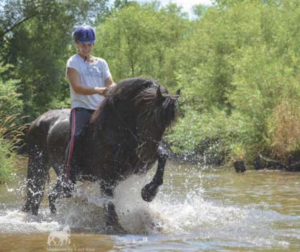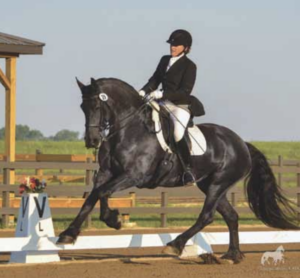The Friesian: Identifying Your Breeding Goals
in newsBy Allison Thomas
Photos by Lori Ann Thwing ©
 The Question: “Who should I breed my mare to?”
The Question: “Who should I breed my mare to?”
This is a question asked hundreds of times by Friesian mare owners each spring. Often it is asked on social media, in breeding groups, or Friesian specific groups, or both. The answers are as varied as the people who answer are – some people offer a stallion’s name, others ask questions about the mare. However, one important question is often overlooked in these discussions.
That question is, “What is your breeding goal?” When the question is asked, a lot of mare owners respond that they want to improve on their mare’s faults. Improving your
mare is always a worthy goal, but it does not really answer the question. There are many ways to improve a mare, and the ones that are most important change depending on what your long term goal for the foal is. In this article, we will discuss how to determine your own breeding goal, and why it matters.
Why Does A Breeding Goal Matter?
Or, “Why can’t I just improve my mare’s weak points?” The answer to this is simple – no mare is perfect, and most mares have more than one or two areas that could use improvement. Trying to improve too many things in one generation usually leads to failing to improve anything, so it is important, when selecting a stallion, to focus on a few key areas that you want
to improve. Knowing your breeding goal will help you identify why certain areas are most important for you, and which areas you can put low on your list.
Breeding Goal Vs. Target Market
In my opinion, the most important part of determining your breeding goal is acknowledging what your target market is. These two things are directly linked, but are not the same. Your target market is the group(s) of prospective buyers that you intend to market your foal towards. Your breeding goal is to produce a foal that will be highly desired by your target market.
There are many different types of horse buyers in the world. Your goal here is to identify which kind of buyer you will eventually market your foal to. Many breeders wait until the foal is 3-6 months old before deciding who they are going to market to, based on how the foal turns out. A breeder who plans their target market before ever signing a stallion contract has an 18 month or more time advantage over those who wait until weaning. That is an extra 18 months to plan your marketing strategy, to come up with ads that highlight your mare, the sire, and why the two compliment each other to produce a foal that this market wants. You can advertise long before the foal is even born, if you know who you are going to advertise to!
 An extremely common mistake is attempting to market a foal to all markets at once – trying to appeal to breeders, amateurs, and competitors all in one ad is a turn off for many prospective buyers. The words “this foal could go in any direction!” can easily translate to “this foal won’t be really good at anything.” Buyers are smart – if they see the foal in different ads, one ad claiming the foal is a great dressage prospect, another ad claiming it will be a great driving horse, a third ad saying it is suited to amateurs, they know that something is off. Very few horses really excel in all of these areas, as these types of buyers are all looking for different things. When you stay focused on a single market, this helps guide where, how, and when you advertise.
An extremely common mistake is attempting to market a foal to all markets at once – trying to appeal to breeders, amateurs, and competitors all in one ad is a turn off for many prospective buyers. The words “this foal could go in any direction!” can easily translate to “this foal won’t be really good at anything.” Buyers are smart – if they see the foal in different ads, one ad claiming the foal is a great dressage prospect, another ad claiming it will be a great driving horse, a third ad saying it is suited to amateurs, they know that something is off. Very few horses really excel in all of these areas, as these types of buyers are all looking for different things. When you stay focused on a single market, this helps guide where, how, and when you advertise.
Even if you plan to keep the resulting foal, it is always important to consider what the market is for that particular foal if at some point in its life it became available for sale. If you plan to keep the foal, then ask yourself – “If I were buying a foal, what would I want?” This puts you in the position of the ‘target market.’
Identifying Your Target Market
When looking at target markets, keep a close eye on your mare’s strengths. If your mare has a relaxed, laid back attitude and movement that is smooth and easy to ride, she is probably not a great candidate for producing a foal that will appeal to buyers who want high premiums at an inspection. She is likely to be an excellent candidate for producing a foal that will appeal to adult amateurs and pleasure riders/drivers. On the other hand, a mare with a hot or sensitive temperament, huge knee action and a giant stride is unlikely to produce a foal that will be appropriate for an amateur to handle or ride. She is much more likely to produce a foal that will appeal to a competitive rider or driver, or to a breeder.
At this point, some readers will be saying, “Well my mare is laid back and has an easy trot to ride and she produces first premium foals!” – and that is fine. There are always exceptions. Breeding is a gamble and you never know precisely what you will get. You are more likely to have success, however, if you do not attempt to produce a foal who is drastically different than its dam. Embrace your mare’s strengths and use them to help guide your breeding choices, rather than picking a goal and trying to change her to fit it. Every mare has something to offer, in the same way that every approved stallion has mares who are right for him. But not every mare is right for every stallion, and vice versa.
There are many different ways to market your Friesian foal, and many different possible target markets for that foal. This is by no means an exhaustive list of those markets, but is rather designed to get you thinking about possible people to market to.
Breeders
This market is often highly concerned with premiums, predicates, and “full papers.” If you are breeding to sell to other breeders (or to keep for yourself as a breeding prospect), then the foal premium is a big thing of note. Breeders most often want to see foals from marelines that are predicate rich, especially marelines that show a lot of Preferent or Prestatie mares. These are marelines who are proven to produce foals who do well at an inspection (Preferent) or in competitive sport (Prestatie).
Stallion selection when breeding for this market should keep an eye on the first and second premium foal percentage of the stallion’s offspring and the star percentage of his adults. Pay close attention to the current breeding goals of the KFPS and how the breeding values of any stallion you consider compare to these goals. Many of the current KFPS breeding goals are linked closely to producing good Sport horses (KFPS Sport Predicate), and so many of the criteria wanted by competitive buyers are also high priority in the KFPS breeding goals. Some important differences are that the KFPS breeding goals are focused on producing Sport horses who maintain the traditional Friesian look and temperament. Tolerance for undesirable breed traits such as a Roman nose, white markings, or very horizontal neck carriage are very low.
Be warned that this is a very small market to breed for, as many breeders are breeding their own bloodlines to keep. Also, as colts are so rarely selected for breeding approval, ensure that if you are breeding for this market, that you have a backup marketing plan for colts.
Competitors and Professionals
This is a market that is growing constantly. The KFPS has spent most of the 21st century working on improving the Friesian horse’s ability as a sport horse, and it has been highly successful in doing so. As more and more Friesians emerge as viable competitors at upper levels of sport, there will be a growing number of competitive riders and drivers interested in the breed.
Competitors and professionals cover a huge number of different disciplines, and each discipline has its own wants and needs in a Friesian in terms of conformation and movement. Some of the wants for each discipline are being covered in past, current, and future articles in The Friesian, such as “Selecting a Friesian for Dressage.” However, there are a few criteria that are commonly wanted among this market that apply to most or all disciplines. This market is often seeking a horse with a bit more ‘spice’ – a more sensitive or hot horse is well tolerated here. Most competitive equestrians do not want a ‘deadhead.’ They should still be highly trainable, but this market will welcome a horse with a lot of presence and some extra pizazz.
The quality of movement is key when marketing to competitors – particularly the walk and the canter. As the trot is a gait that can be significantly improved by training, it is often of lesser concern, especially in a foal. The quality of the walk and the canter, however, are often extremely important to these buyers. The conformation is important in terms of functional use and longevity rather than based on breed standards.
This is the key difference between what a KFPS breeder wants versus what a competitive equestrian is looking for in a Friesian foal. Breed standards such as an upright neck, slightly dished head, jet black color, and ample hair are important for the Friesian racial type, but these characteristics mean little to those whose primary competitive goal is not to achieve high premiums at an inspection. This target market has a high tolerance for things like white marks, faded coloring, or a lack of hair, as none of these things impact the horse’s ability to perform. Stallion selection when producing for this market should focus on the quality of the walk, canter, and on correcting conformation faults that might hinder the foal’s athletic ability or longevity of use.
Adult Amateurs & Recreational Owners
This market is likely the largest market of buyers seeking a Friesian foal. This market ranges from the first time horse owner who has always dreamed of owning a Friesian, to the experienced horseperson who wants a Friesian to trail ride, or compete casually. It covers the horse who will be a family pet and companion rather than a high powered competitor. These buyers are usually one or two horse owners, with no intention to breed, and who – if they show at all – will likely attend schooling shows, parades, and clinics. This market is not looking for the next Grand Prix Friesian or the next Model mare – they want a safe and sane partner to love and enjoy.
Typically, the highest priority for this category of buyers is temperament. They do not want a spooky or hot horse that they are unable to handle themselves. They want a horse that displays the traditional calm, caring, connected personality of the Friesian breed.
Also important to this group is the ‘Friesian’ look. Particularly in the North American market for Friesians, many people want the older, more baroque style Friesian look that first attracted them to the breed. A heavier built horse is often preferred, with hair and true black color being highly sought after. Some conformation faults can be tolerated in this group – the shorter forearm or downhill build with a shorter, heavier neck that used to be common in Friesians is generally not a problem for the pleasure/amateur owner. While breeding for better conformation is always important, this group is the most tolerant towards these kinds of faults.
The last thing to be aware of in this group – particularly if you wish to market to older adult amateurs – is movement. Most mature riders want movement – particularly at the trot – that won’t jar their bodies too severely. The huge stride and high knee action of a Friesian with an ‘8’ for a trot score is often incredibly difficult to sit, and is not as desirable for the adult amateur as a flatter stride is. That trot that may earn a foal ‘Champion Foal’ at an inspection is unlikely to appeal to this target market.
When selecting a stallion to breed to your mare for this market, be sure to ask a lot of questions about his temperament and that of his foals. Some stallions are known for producing very easy, calm temperaments, and that is important. Some stallions are known for hotter or more sensitive temperaments. However, studies have shown that temperament is more strongly influenced by the mare. If your mare is particularly calm and sensible, a slightly hotter stallion may still be acceptable. Conversely, if your mare is more sensitive, temperament is an area to overcorrect for in the stallion if you are hoping to produce amateur friendly foals.
These are just a few possible markets to consider when thinking about your foal. There are many, many more, so do not feel limited to these three! You as the breeder have the task of determining the market you plan to cater to, and then identifying the breeding goals that will satisfy that market. When your breeding goals are clearly defined, it is much easier to select a stallion for your mare that will produce the foal you want.
The FHANA Resource Book
THE FHANA Resource Book is now available for order. This publication is good for all NEW and SEASONED members alike. Contact FHANA to obtain your copy today.
